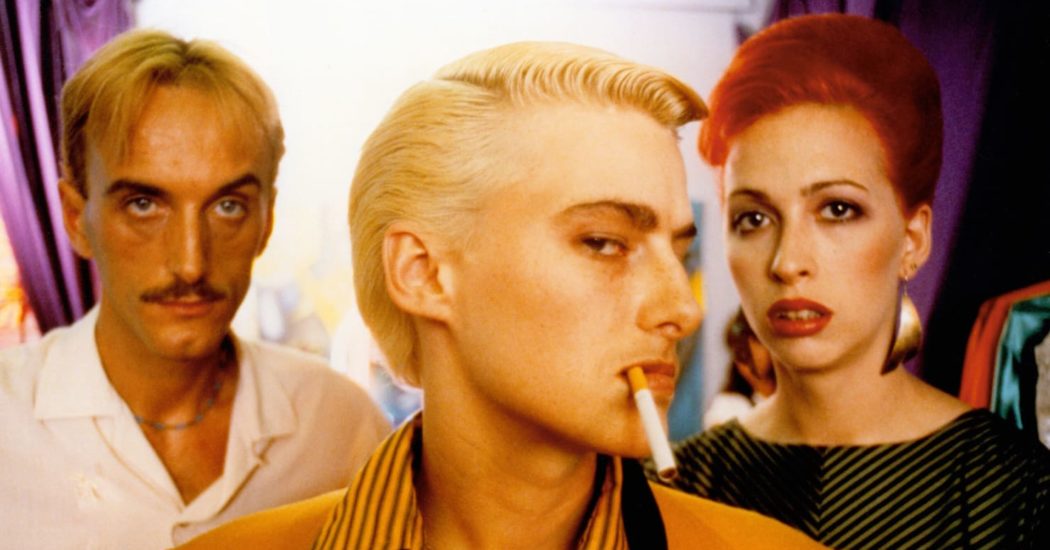
Cinema Fearité presents 'Liquid Sky'
Cult classic 'Liquid Sky' is a weird, crazy movie.
It’s always fun when one actor gets to play multiple roles in the same movie. Sometimes, it’s twins (Sisters, Dead Ringer, The Black Room, Jack’s Back) or doppelgangers (Enemy, +1). Other times, it’s a more creative use of the characters (Alien: Covenant, Nocturnal Animals). Still other times, it’s a thematic motif (Cloud Atlas, Holy Motors, Anomalisa). And sometimes, it’s just for show. That’s the case with Liquid Sky.

Liquid Sky takes place in the middle of the New York City new wave party scene of the early eighties. The colorful cast of characters includes a young model named Margaret (Anne Carlisle from Desperately Seeking Susan and Perfect Strangers) and her rival, an androgynous druggie named Jimmy (also played by Carlisle).
Margaret’s girlfriend is a performance artist named Adrian (Alice, Sweet Alice’s Paula E. Sheppard), who is also Jimmy’s cocaine dealer. There’s also a failed writer-turned-junkie named Paul (Mother’s Day’s Stanley Knapp) who is constantly arguing with his girlfriend, Katherine (Elaine C. Grove from The Riverbed), about his drug use. Finally, there’s Jimmy’s mother, an emotionally fraught television producer named Sylvia (Bloodrage’s Susan Doukas), who wants to seduce a German UFO investigator named Johann (Otto von Wernherr from The Package).

The reason Johann is around is because there are also a handful of tiny aliens that have landed on the roof of Margaret’s apartment building in a little flying saucer. The aliens have come to Earth searching for heroin, but have found that the chemical produced by the human body during sex is just as effective for their needs. So, every time Margaret has sex, the aliens kill her partner in order to harvest the chemical reaction.

That’s about as much of a story as there is to Liquid Sky. In short, it is one weird, crazy movie. Directed by Slava Tsukerman (Perestroika) in 1982 from a screenplay that he wrote with star Anne Carlisle and producer Nina V. Kerova, Liquid Sky functions more as a time capsule of eighties New York and a character study of a bunch of dysfunctional misfits than it does as a narrative movie. The alien subplot almost comes off as secondary, just a way to loosely tie the events of the movie together into one semi-coherent plot.

Liquid Sky feels like the Anne Carlisle show. Aside from co-writing the feature, Carlisle plays both Margaret and Jimmy. The characters are professional rivals, but also have a lot in common. Both are fairly androgynous, but emit an air of sexuality. Both are drug-fueled individuals who are looking for love in all the wrong places. Carlisle’s portrayal of Margaret seems almost like an organic extension of her own personality. Her performance as Jimmy is a bit less effective, coming off as an obvious female playing a male role, right down to the unnaturally low baritone that she speaks with in order to mask the lack of testosterone.
Physically, the transformation is uncanny, sometimes looking like the characters are played by siblings rather than by the same actor. Margaret and Jimmy share several scenes, so a great deal of credit must be given to Slava Tsukerman and cinematographer Yuri Neyman (D.O.A.) for finding creative ways for Carlisle to appear onscreen with herself. Liquid Sky may be the only movie ever made where one of the actors performs oral sex on themselves (as two different characters, of course).

For what is ostensibly an alien invasion movie, there is a distinct lack of aliens in Liquid Sky. The galactic visitors are never shown to the viewer; their presence is implied by their spacecraft, and their actions are illustrated by clever POV shots. Johann the alien investigator explains most of the alien subplot to the audience verbally, removing the need to show the tiny spacemen. The absence of a visual representation of what is essentially a major plot device just makes Liquid Sky that much weirder of a movie.

From a visual standpoint, Liquid Sky is a bright and colorful movie, almost dayglow with its use of florescent coloring and blacklight effects. The looks of Margaret and her fellow models are obviously influenced by Aladdin Sane-era David Bowie, with bleached wavy hairstyles and sharp angled graphic makeup, making them appear as if they’ve just stepped out of a Patrick Nagel painting.
The sets and surroundings are colorful as well, giving the entire film a neon aesthetic. When the film takes the alien’s point of view, there’s an even more colorful, heat-sensing filter put on the camera, that shines bright images right when the subjects climax, either from drug use or from sexual pleasure. Liquid Sky’s inimitable style is one of the reasons why the film has become such a huge cult hit.

The music in Liquid Sky is also stylistically unique, but only because it captures the new wave era during which the movie is set. The cinematic score, composed by Slava Tsukerman along with Clive Smith and Brenda I. Hutchinson (neither of whom have any other film scoring credits), falls somewhere between Giorgio Moroder and Cliff Martinez; it’s an electronic synth score that would be equally as comfortable in Flashdance and Scarface as it would be in The Neon Demon and Hotel Artemis.
Of course, there are also dance club songs, and one performance piece performed by Paula E. Sheppard’s Adrian called “Me and My Rhythm Box” that provides the soundtrack to one of the most memorable scenes in the film. Just as one might imagine, the music sets the scene in Liquid Sky.

One can’t really say that Liquid Sky is a great movie. One might even be hard pressed to call it good. But it is both unique and memorable, and in some ways, that’s better than being good. Liquid Sky is unforgettable, and that cements its legacy as a cult classic.
